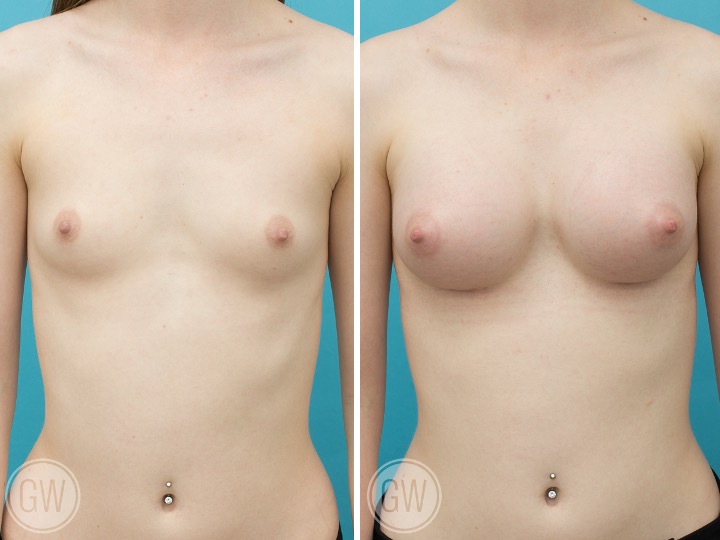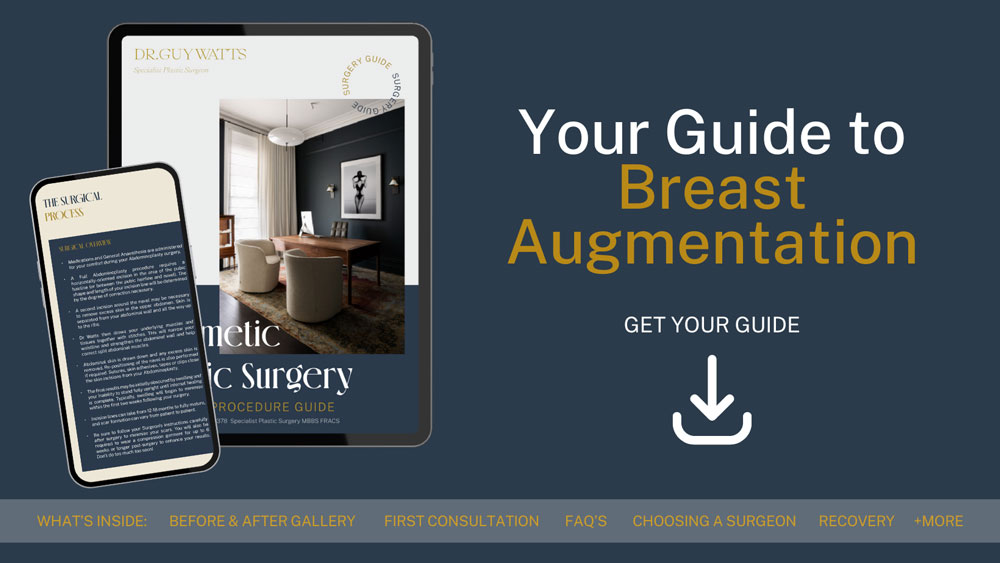
21 Jul Biggest Mistakes Surgeons Make with Breast Augmentation Surgery
The Importance of Getting It Right
Breast augmentation is a popular and highly refined procedure designed to address breast size and shape. However, achieving the optimal outcome requires more than simply choosing implants. The planning, technique, and recovery process all play significant roles in determining long-term satisfaction. Dr. Guy Watts, a Specialist Plastic & Reconstructive Surgeon in Perth, Western Australia, emphasises that while breast augmentation can be a safe and effective procedure, certain avoidable mistakes can lead to complications, unnatural results, or the need for revision surgery.
By understanding these common pitfalls, patients can make informed decisions and work with their surgeon to achieve a result that looks natural, feels comfortable, and lasts for years.
Take our quiz, and find out if you are ready for surgery
✗ Insufficient Pre-Surgical Planning
Proper planning is essential for a successful breast augmentation. One of the most common mistakes is failing to account for individual anatomy when selecting implants. Factors such as chest width, breast tissue thickness, skin elasticity, and natural breast shape all influence which implant size and shape will provide the most proportional and long-lasting result. If these considerations are overlooked, the outcome may look disproportionate or cause long-term issues such as sagging or discomfort.
Additionally, patients should consider how their breast implants will age with their bodies. Lifestyle factors, weight fluctuations, and future pregnancies can impact results over time. A thorough consultation allows for personalised planning that takes both current aesthetic goals and future changes into account.
Realistic expectations are also a key part of pre-surgical planning. A common mistake is misalignment between the patient’s vision and what can be realistically achieved. Open communication with the surgeon means that both parties understand what is possible, helping to prevent disappointment.
✗ Choosing the Wrong Implant Type or Size
Selecting the right implant requires more than simply choosing a desired cup size. One of the most frequent mistakes is opting for implants that are too large for the patient’s frame. While some individuals may initially prefer a more dramatic change, excessively large implants can cause long-term strain on breast tissue, leading to premature sagging, back and neck discomfort, and a less natural appearance. A well-proportioned implant choice helps maintain breast shape and comfort for years to come. Dr. Guy Watts offers further insight on why he prefers Mentor implants for breast augmentation procedures, discussing their design, safety profile, and aesthetic outcomes in this article.
Another factor to consider is implant shape. Some patients benefit from round implants, which provide more upper fullness, while others achieve a more natural contour with anatomical (teardrop-shaped) implants. Selecting the wrong shape for a patient’s body type or expectations can lead to dissatisfaction with the final outcome.
Lifestyle is another consideration. Individuals who engage in high-impact sports or weightlifting may require specific implant characteristics to assist with comfort and prevent movement. Patients should discuss their daily activities with their surgeon to determine the most suitable implant type and placement for their needs.
DOWNLOAD DR WATTS’ GUIDE TO BREAST AUGMENTATION

✗ Incorrect Implant Placement
The decision of whether to place implants above or below the muscle significantly affects both aesthetics and function. There are advantages and disadvantages to both approaches, and failing to tailor implant placement to the patient’s body type can result in poor results.
When implants are placed under the muscle (submuscular), they typically provide a more natural slope and reduce the risk of visible rippling. However, this placement can sometimes cause movement of the implants during muscle contraction, which may be noticeable in patients with highly developed pectoral muscles.
Placing implants above the muscle (subglandular) allows for a more defined shape and often involves a shorter recovery period. However, this approach may not be ideal for patients with minimal breast tissue, as it can increase the risk of visible implant edges and a less natural feel.
Each patient’s breast tissue, skin thickness, and long-term goals should be considered before determining the best implant placement. A tailored approach reduces the likelihood of complications and enhances the overall outcome.
✗ Overlooking Breast Symmetry
Breast asymmetry is common, yet it is often underestimated when planning breast augmentation. Many patients have subtle differences in breast volume, nipple position, or overall shape. If a surgeon uses identical implants on asymmetric breasts without making necessary adjustments, the final outcome can exaggerate these differences rather than correct them.
In cases where one breast is naturally smaller, using different implant sizes or adjusting the implant pocket during surgery can help create a balanced result. Additionally, some patients may benefit from a minor breast lift or nipple repositioning to achieve optimal symmetry.
A well-executed augmentation should enhance the patient’s natural proportions rather than highlight pre-existing asymmetries. Careful preoperative measurements and planning allow for a more harmonious outcome.
✗ Poor Incision Placement and Scar Management
While breast augmentation incisions are small, their placement is critical for both aesthetic and functional reasons. There are three primary incision locations: inframammary (under the breast fold), periareolar (around the nipple), and transaxillary (under the armpit). Each has benefits and limitations, and selecting the wrong incision site for a patient’s anatomy can impact scar visibility, implant positioning, and long-term satisfaction.
The inframammary incision is one of the most commonly used, as it provides excellent access for implant placement and tends to heal discreetly beneath the natural breast fold. The periareolar incision may be appropriate for patients who require additional nipple repositioning, but it may not be suitable for those with smaller areolas. The transaxillary incision avoids scarring on the breast itself, but it is less commonly used and may provide limited precision in implant placement.
Proper scar management is also an essential part of post-operative care. Patients should follow their surgeon’s recommendations for wound care, including using silicone-based scar treatments and avoiding excessive sun exposure. Small adjustments in scar care can make a significant difference in how incisions heal over time.
✗ Rushing the Recovery Process
The recovery phase is just as important as the surgery itself, yet it is often underestimated. Some patients feel eager to return to their normal activities too soon, which can put stress on healing tissues and affect implant positioning. Surgeons must provide clear post-operative guidelines regarding activity restrictions, sleeping positions, and proper wound care.
Wearing a well-fitted post-surgical support bra is essential for stabilising the implants and reducing swelling. Failing to wear the recommended garment or switching to underwire bras too soon can compromise the final results.
Follow-up appointments are another critical aspect of recovery. Regular check-ins with the surgeon allow for early identification of any issues, ensuring that healing is progressing as expected. Patients who adhere to their post-surgical care instructions typically achieve the best long-term outcomes.
For a detailed guide on what to expect during this crucial time, read our post on Recovery After Breast Augmentation.
FAQs about Common Breast Augmentation Mistakes
Further Reading
- Read more about Guy Watts’ blog on What Are Normal Symptoms to Experience During Breast Reduction Recovery
About Dr. Guy Watts – MED0001539378
FRACS (Plas) – Specialist Plastic Surgeon In Perth WA
Dr. Guy Watts is a Specialist Plastic Surgeon (AHPRA MED0001539378) with an extensive career that spans across renowned plastic surgery clinics worldwide. His experience has been honed through invaluable experiences at esteemed establishments such as the New York Eye and Ear Infirmary and the renowned Pitanguy Clinic in Brazil.
Having collaborated with the foremost cosmetic plastic surgeons on a global scale, Dr. Watts has chosen to return to Perth after a 17-year journey of intensive training and invaluable professional experience to bring the latest practices and technology in cosmetic plastic surgery to his patients.
Dr. Watts is a Fellow of the Royal Australasian College of Surgeons (FRACS) and a Member of the Australian Society of Plastic Surgeons (ASPS), Australasian Society of Aesthetic Plastic Surgeons (ASAPS) and the International Society of Aesthetic Plastic Surgeons (ISAPS).
Read about the potential Risks and Complications of Surgery
Read the Patient Information and Resources
About CLINISPA
Clinispa is Dr Watts’ bespoke medical clinic performing Cosmetic Aesthetic treatments. At Clinispa, we offer advanced clinical treatments in a luxurious and calming environment, tailored to support your skin’s health and appearance.
Clinispa aesthetic services are performed by Dr Guy Watts’ nursing professionals, who have a passion for and solid understanding of facial aesthetics.
All Clinispa clients are considered individually, with a personalised treatment plan consisting of advanced scientific approaches to cosmetic aesthetics. We incorporate innovative technologies in conjunction with superiorly formulated skin care.
For more information about the full range of Clinispa Aesthetic of Cosmetic Treatments visit the Clinispa website








Sorry, the comment form is closed at this time.